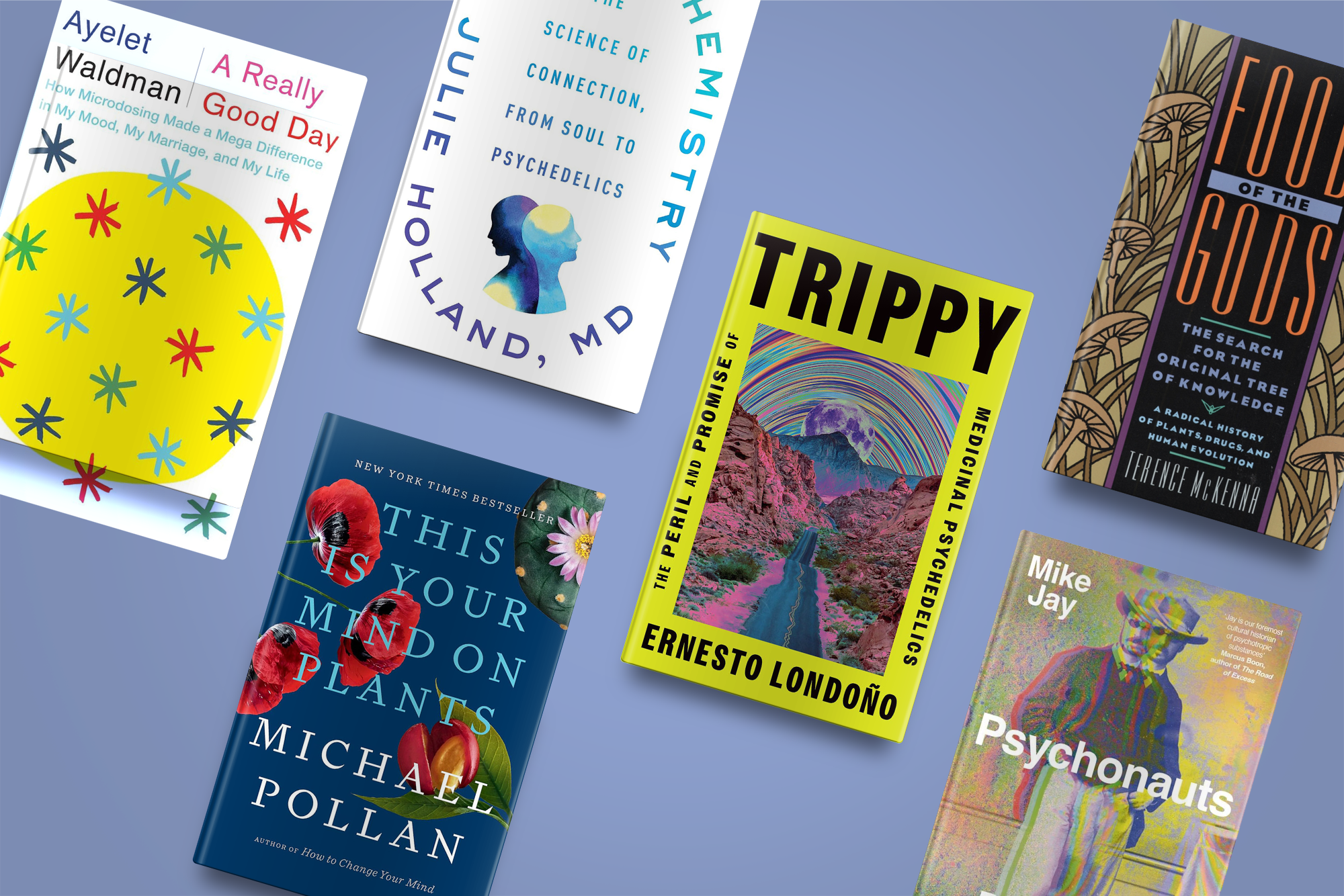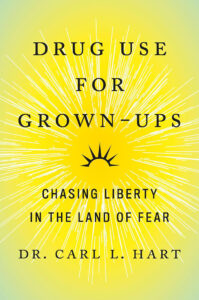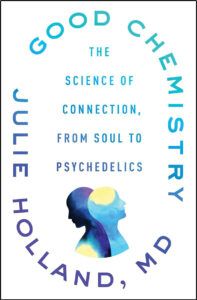After years of stigmatization and heavy-handed policing, psychedelics are entering a new era of acceptance and attention. If you’re interested in learning more about psychedelics and the growing body of research around their medicinal and therapeutic properties, this list is for you. The following books about psychedelics span groundbreaking classics to bold new investigations. Written by journalists, doctors, researchers, and more, these thought-provoking reads will open your eyes and broaden your perspective.
11 Stimulating Books About Psychedelics

These revelatory reads are sure to expand your mind.

Trippy: The Peril and Promise of Medicinal Psychedelics
By Ernesto Londoño
In 2018, after narrowly surviving a crushing battle with depression, veteran New York Times journalist Ernesto Londoño signed up for a nine-day ayahuasca retreat in the Brazilian rainforest. Trippy is both a candid account of his life-changing experience at the retreat and a deeply researched exploration of the emerging field of psychedelic therapy. Londoño’s own positive response to ayahuasca undergirds his investigation: Across the pages of his nonfiction narrative, he interviews scientists, psychedelic enthusiasts, Indigenous leaders, and military veterans suffering from PTSD about the use of medicinal psychedelics in trauma treatment and healing. But Londoño’s research isn’t without nuance — the journalist is also careful to highlight the potential dangers of this developing medical frontier.
Expertly researched and told, Trippy is a book about psychedelics that belongs in everyone’s library. “This journey inside the brain and around the world taught me more than any book I've read in a long time. It's an important book, one that will save people’s lives.” (Benjamin Moser, Pulitzer Prize–winning author of Sontag: Her Life and Work)

This Is Your Mind on Plants
By Michael Pollan
Prolific journalist and thought leader Michael Pollan has written multiple books that deconstruct how our society understands food, diet, and plants. In This Is Your Mind on Plants, he seeks to upend political, cultural, and social assumptions around the naturally occurring substances we define as “drugs.” Specifically, he uses mescaline, caffeine, and opium to illustrate the arbitrary ways in which certain plant-based drugs are deemed acceptable. Why is brewing a cup of strong green tea in the morning okay but brewing tea made from opium to relax isn’t? Why are only certain kinds of mind-altering plants legal? Pollan’s striking blend of cultural history, personal narrative, and scientific research will leave you thinking about your next morning coffee a little differently. For further reading, check out Pollan’s 2019 book on the science of psychedelics, How to Change Your Mind.

The Promise of Psychedelics: Science-Based Hope for Better Mental Health
By Dr. Peter Silverstone
A leading expert on psychedelic mental health therapy, Dr. Peter Silverstone has written a beginner’s guide to understanding the advancements in treating conditions like PTSD, clinical depression, anxiety, addiction, and personality disorders with psychedelics. Steeped in groundbreaking scientific research but written in accessible language, The Promise of Psychedelics explains everything from the labyrinthine FDA approval process to the mind-altering substances that offer the most promising results in treatment trials. It’s a fascinating book about psychedelics that doubles as a handy guide for anyone interested in alternative treatment methods.

A Really Good Day: How Microdosing Made a Mega Difference in My Mood, My Marriage, and My Life
By Ayelet Waldman
After failing to find any treatment for her unbearable mood disorder, writer and former public defender Ayelet Waldman decided to take a chance on an increasingly popular treatment: microdosing LSD. Once vilified as a counterculture indulgence, microdosing LSD has become a cutting-edge approach to treating a range of mental health and mood disorders. In A Really Good Day, Waldman charts her own experiences, both good and bad, while digging into the history and research of the drug and the laws that control it. It’s as entertaining as it is incisive, and you’ll come away from this book with a newfound understanding of the promise of medicinal LSD.

Doors of Perception
By Aldous Huxley
Aldous Huxley’s groundbreaking investigation into psychedelics set the stage for visionary works by writers like Hunter S. Thompson, Tom Wolfe, and William S. Burroughs. Originally published in 1954, Doors of Perception is a firsthand account of the famed sci-fi writer’s psychedelic experience taking mescaline. The narrative blends philosophy and science with a deep dive into the relationship between mysticism, psychology, and mind-altering substances. Even after 70 years, Huxley’s Doors of Perception remains a widely influential book about psychedelics, one that takes seriously the mind-expanding possibilities of psychedelic use.

Psychonauts: Drugs and the Making of the Modern Mind
By Mike Jay
Before the 20th century, it was common for scientists to experiment on themselves to figure out how psychedelic drugs affected the human mind and body. Their widely published accounts then sparked conversation and interest among the public — until the exploration of drugs became both socially taboo and highly criminalized. In Psychonauts, historian Mike Jay delves into this unknown history, raising thought-provoking questions about what we lost when psychedelic drugs went from a topic of study and discussion to a highly policed social problem. As psychedelic inquiry is coming back into the national conversation, understanding the past work of researchers, scientists, writers, and philosophers gives us a useful framework to push the field forward.

The Immortality Key: The Secret History of the Religion with No Name
By Brian C. Muraresku
A lawyer by trade, Brian C. Muraresku has long been interested in the intersection of the law, history, religion, and drugs. His interest led him on a globe-trotting exploration of the possible use of psychedelics in early Christian sacraments, which he chronicles in this fascinating historical deep dive. Many have compared The Immortality Key to Dan Brown’s Da Vinci Code for the way it unfolds like a detective tale, full of twists, turns, and religious cover-ups. Beneath Muraresku’s entertaining writing, though, are serious questions about the role psychedelics played in the rise of Christianity in ancient Greece and why the church distanced itself from the substances as it evolved.

I Feel Love: MDMA and the Quest for Connection in a Fractured World
By Rachel Nuwer
MDMA, often referred to as Molly or Ecstasy, has long been associated with parties, EDM, and raves. But now there’s growing interest in its potential therapeutic properties, which science journalist Rachel Nuwer explores in I Feel Love. Nuwer cuts through the hype and controversy to lay out the compelling history of the drug, tracing its origins and pointing to promising evidence that MDMA serves as a revolutionary treatment for a host of issues, from depression to alcohol addiction to eating disorders. “Excellently researched,” I Feel Love “makes a convincing argument for MDMA’s potential as a therapeutic supplement, especially for those working through trauma” (Scientific American).

Drug Use for Grown-Ups: Chasing Liberty in the Land of Fear
By Dr. Carl L. Hart
Columbia University psychology professor Dr. Carl L. Hart channels his scientific expertise and personal experience with the physical and mental effects of drugs into this finely argued and thoroughly researched treatise on changing the conversation about drug use. Drug Use for Grown-Ups makes the case that when used for specific purposes in responsible ways, what we call “recreational drugs” can enrich our lives. The author also maintains that scientific facts don’t support the criminalization of drug use and that America’s War on Drugs has led to nothing but the upholding of structural inequality and discrimination and the victimization of minority communities by the criminal justice system.

Good Chemistry: The Science of Connection, from Soul to Psychedelics
By Julie Holland
Experts know this, and perhaps you’ve felt it, too: Much of the world seems to suffer from social isolation and disconnection. In her book Good Chemistry, psychiatrist and psychopharmacology specialist Julie Holland delves into the science of connection, suggesting that one way to counteract this isolation epidemic is through psychedelic medicine. Holland outlines a range of activities that allow us to form deeper attachments with others and heal our isolation and distrust, from meditation to reveling in the beauty of the natural world. At the center of this process is oxytocin, a hormone and neurotransmitter that helps us create bonds and establish trust. Psychedelics, Holland argues in her book, may point out the path to supercharging the chemicals we need to rebuild our lost connections.

Food of the Gods: The Search for the Original Tree of Knowledge — A Radical History of Plants, Drugs, and Human Evolution
By Terence McKenna
An ethnobiologist, author, and lecturer, Terence McKenna was a leading expert in the psychedelic movement of the 1980s and ’90s, with a focus on plant-based drugs like psilocybin mushrooms, and ayahuasca. In Food of the Gods, one of his most famous works, McKenna explores the role psychedelics played in the evolution of primitive humans and human societies. He proposes that as our distant ancestors left the forests for the grasslands and savannas, they encountered a range of new edible substances — including psychedelics. The introduction of psychoactive ingredients into our ancient diet, McKenna argues, was instrumental in nearly every aspect of our development as a species, from increased visual acuity to society-building and the emergence of spoken language. Sweeping in its scale, McKenna’s narrative is a must-read book about psychedelics for psychonauts and history buffs alike.
Share with your friends
Related Articles
Celadon delivered
Subscribe to get articles about writing, adding to your TBR pile, and simply content we feel is worth sharing. And yes, also sign up to be the first to hear about giveaways, our acquisitions, and exclusives!
Celadon delivered
"*" indicates required fields


